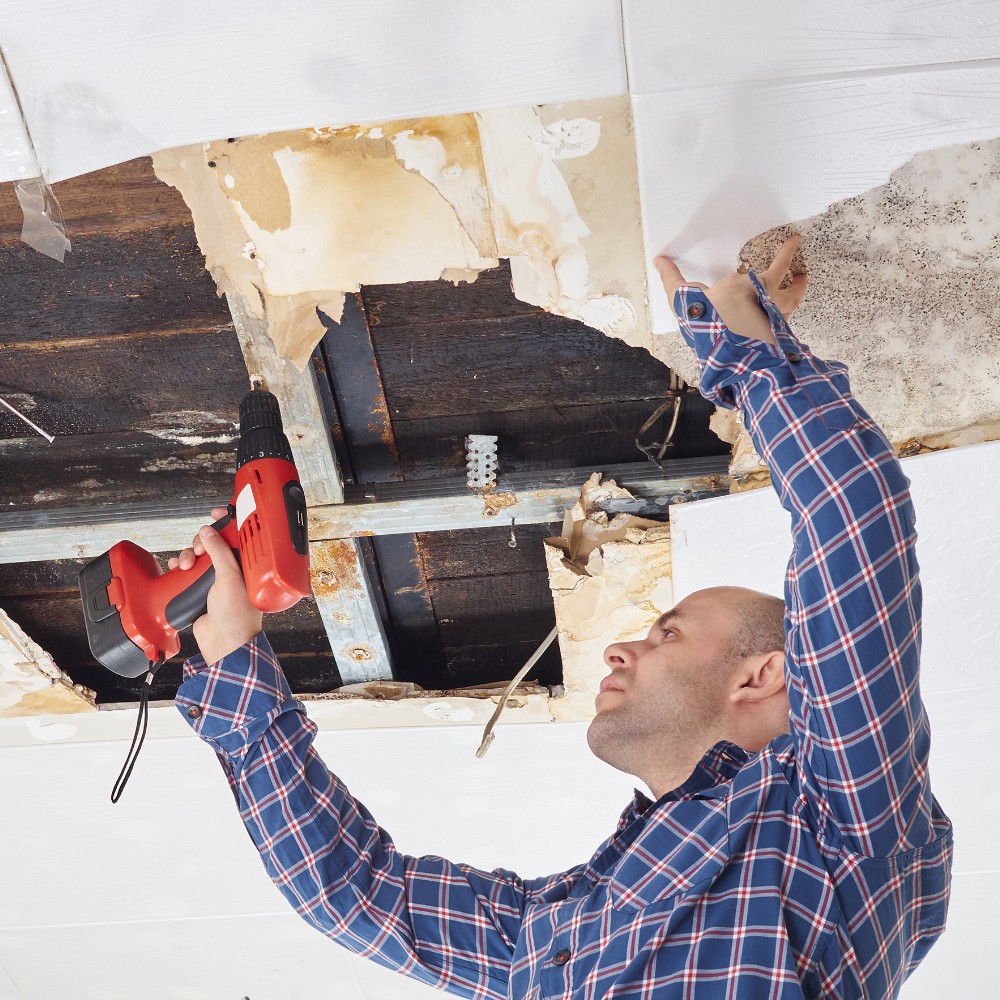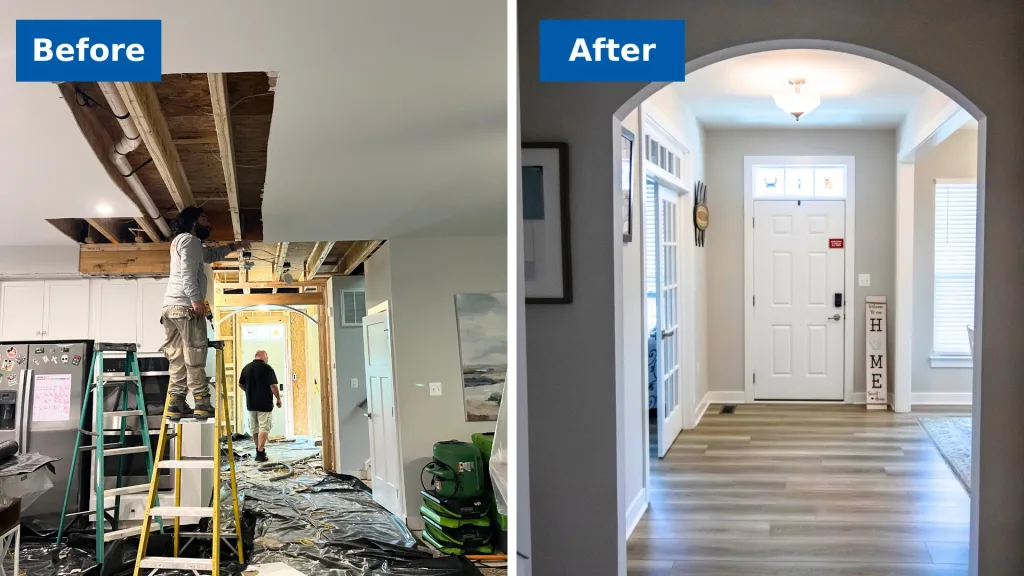Important Actions to Adhere To for Efficient Water Damage Repair in your house
When confronted with water damage in your house, recognizing the important actions for reliable reconstruction can make all the distinction. You need to examine the damage and guarantee safety and security before tackling the trouble. Quiting the source of water is crucial, however it's just the start. There's a collection of activities you should take to shield your residential property from further issues when you have actually handled that. Allow's explore what you must do next.
Analyze the Damages
When you discover water damage in your home, the very first step is to assess the damages thoroughly. Start by recognizing the resource of the water intrusion. Look for leaks, burst pipelines, or various other issues creating the problem. Next off, examine the impacted locations for noticeable signs of damage, consisting of warping, staining, or mold development. Do not forget to look in concealed places like behind wall surfaces or under flooring, as water can permeate right into these locations unnoticed.Document the damage by taking clear pictures and notes. When talking about the situation with your insurance coverage supplier or repair experts, this will certainly assist you. Pay interest to the kind of products influenced, as various products call for various reconstruction strategies. Examine the degree of the damages. Is it considerable or small? Comprehending the range will guide you in deciding whether to manage it yourself or hire the experts for a more comprehensive remediation procedure.

Ensure Security
Prior to you begin any repair job, assuring your safety is vital. Assess the condition of your home. If the water's deep or if you observe electric threats, do not get in the location. Shut off the electrical energy and gas supply to avoid mishaps. Use safety equipment like boots, handwear covers, and masks to shield on your own from pollutants or mold.It's vital to stay knowledgeable about your environments; look for slippery surface areas and sharp things. Treat it as harmful waste if the water is from a sewer back-up. Maintain youngsters and pets away from influenced locations to prevent exposure.Once you have actually taken these safety measures, you can proceed with the remediation process. Remember, your safety and security precedes, and if you're ever unsure, it's best to get in touch with a specialist. Taking these steps will assist assure you're ready to deal with the repair safely and properly.
Stop the Resource of Water
After guaranteeing your safety, the following action is to quit the resource of water. Identify where the leak is coming from. Maybe a ruptured pipe, a malfunctioning appliance, or perhaps heavy rain going into via a damaged roof. Transform off the main water supply to your home to protect against more flooding if it's a pipes concern. For home appliances, disconnect them and shut off their water supply valves.If the resource is outdoors, like rainwater, attempt to divert it far from your home making use of sandbags or various other obstacles. For small leaks, you may be able to utilize tape or a sealant temporarily until an expert can fix it. Bear in mind, attending to the source swiftly is important to lessening damages and stopping mold growth. When you've stopped the water, you'll be in a much better placement to carry on to the next action in the remediation process.

Get Rid Of Excess Water
Act promptly to remove excess water, as standing water can cause a lot more extensive damages and mold development. Initially, gather your devices: a wet/dry vacuum cleaner, buckets, and towels. You can utilize towels to saturate up the dampness if the water is superficial. For much deeper water, a wet/dry vacuum cleaner is your best option. Make sure to empty the vacuum frequently to prevent overflow.If the water is polluted, like from a sewer back-up, put on safety gear, including masks and handwear covers, to keep on your own risk-free. Once you've gotten rid of as much water as possible, look for hidden pockets of moisture in edges and under furnishings, as these can nurture mold.Don' t fail to remember to switch off electric devices and power electrical outlets in wet areas to avoid risks. This initial action is crucial in decreasing damage and setting the stage for an effective repair procedure.
Dry and Dehumidify the Location
Once you've gotten rid of the excess water, it's necessary to dry and evaporate the area extensively. Begin by using dehumidifiers properly to pull dampness out of the air and stop mold and mildew growth. Watch on humidity levels to guarantee the area dries completely.
Remove Standing Water
To efficiently deal with water damage, you require to focus on getting rid of standing water as quickly as possible. Begin by gathering essential tools, like a wet/dry vacuum or a pump, depending on the volume of water. A vacuum cleaner must do the technique if the water is shallow. For larger quantities, a pump is extra efficient. While working, make certain to wear safety equipment to keep yourself risk-free from pollutants. As you get rid of the water, take notice of concealed locations like under furniture or in corners where water could gather. Once you've eliminated the majority, your room will certainly begin to dry. This step is vital, as lingering water can bring about mold development and more extensive damage.
Use Dehumidifiers Effectively
How can you properly utilize dehumidifiers to completely dry and dehumidify your space? Begin by placing your dehumidifier in one of the most affected location, preferably where water damage is most severe. See to it to shut all windows and doors to create a covered atmosphere. Switch on the dehumidifier and established it to the suitable humidity level, generally around 30-50%. Empty the water collection tank often, or consider utilizing a version with a continual water drainage option for comfort. Ideally, utilize fans to enhance airflow, helping the dehumidifier work much more successfully. Maintain the dehumidifier running until you're positive that the area is extensively dried, preventing mold development and added damage (Water Damage Restoration why not try here St George UT). This step is vital for reliable water damages repair
Screen Humidity Degrees
Tracking humidity degrees is important throughout the drying out procedure, as it aids ensure your room remains without excess moisture. Purchase a trustworthy hygrometer to track humidity precisely. Ideally, you intend to preserve degrees between 30% and 50%. You may require to readjust your fans or dehumidifiers to boost air movement if humidity readings increase above this range. Examine the analyses routinely, especially in locations susceptible to dampness, like cellars or restrooms. If you discover persistent high moisture, think about increasing air flow or utilizing added dehumidifiers. Remaining on top of these levels not only quickens the drying process yet additionally prevents mold and mildew growth, hop over to here guaranteeing your home stays safe and comfortable.
Tidy and Disinfect Affected Surfaces

Bring back and Repair Your Home
After cleaning and disinfecting the impacted locations, it's time to recover and repair your home. Begin by evaluating the damage. Check for architectural concerns, like weakened floorings or walls, and deal with any type of required fixings. Replacing harmed drywall or flooring is important for both visual appeals and safety.If your furniture or personal belongings were influenced, think about whether they can be recovered or require substitute. Tidy or professionally recover things where possible.Next, touch and repaint walls up any type of locations that need focus. This not just improves appearance however likewise protects surfaces from future water damage.Don' t forget to check your plumbing and appliances for leakages, ensuring everything's operating effectively. Take into consideration installing a dehumidifier to prevent future wetness problems. By taking these steps, you'll recover your home to its former splendor and create a safer living atmosphere.
Often Asked Questions
For How Long Does Water Damages Repair Generally Take?
Water damage repair commonly takes anywhere from a few days to numerous weeks, depending upon the level of the damages (Water Damage Repair). You'll want to assess the circumstance quickly to decrease further problems and assure correct restoration
Will My Insurance Coverage Cover Water Damage Remediation Costs?
Your insurance coverage may cover water damage restoration prices, but it relies on your plan. Check your coverage information and contact your insurance agent to clarify what's included and what you need to sue.
Can I Deal With Water Damages Restoration Myself?
You can take care of water damages reconstruction yourself, but it's essential to analyze the circumstance first. If it's comprehensive, you might wish to call professionals. Constantly focus on safety and security and assure you've got the right devices.
What Are the Indications of Hidden Water Damages?
You might discover indicators of covert water damages like distorted wall surfaces, musty odors, or discoloration. If your floorings feel mushy or you place mold and mildew, it's time to check out even more before the more tips here situation intensifies.
How Can I Stop Future Water Damage in My Home?
To protect against future water damages in your house, you need to consistently evaluate plumbing, seal cracks, maintain seamless gutters, and assurance appropriate water drainage. Setting up a sump pump and dampness barriers can also aid maintain your area dry. When you discover water damage in your home, the initial action is to examine the damage extensively. Act promptly to remove excess water, as standing water can lead to a lot more extensive damages and mold and mildew growth. To successfully take on water damage, you need to focus on eliminating standing water as promptly as possible. As you get rid of the water, pay attention to concealed areas like under furniture or in corners where water could accumulate. Water damage repair commonly takes anywhere from a few days to numerous weeks, depending on the extent of the damage.